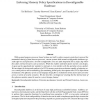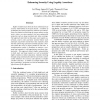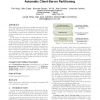22 search results - page 2 / 5 » A Run-Time Memory Protection Methodology |
COMPSEC
2008
13 years 10 months ago
2008
While general-purpose processor based systems are built to enforce memory protection to prevent the unintended sharing of data between processes, current systems built around reco...
CCS
2001
ACM
14 years 2 months ago
2001
ACM
Abstract. Protection of software code against illegitimate modifications by its users is a pressing issue to many software developers. Many software-based mechanisms for protectin...
WCRE
2005
IEEE
14 years 3 months ago
2005
IEEE
Buffer overflows have been the most common form of security vulnerability in the past decade. A number of techniques have been proposed to address such attacks. Some are limited t...
VTS
2007
IEEE
14 years 4 months ago
2007
IEEE
Conventional error correcting code (ECC) schemes used in memories and caches cannot correct double bit errors caused by a single event upset (SEU). As memory density increases, mu...
WWW
2007
ACM
14 years 10 months ago
2007
ACM
Data-driven web applications are usually structured in three tiers with different programming models at each tier. This division forces developers to manually partition applicatio...



